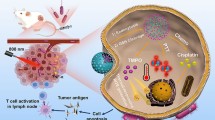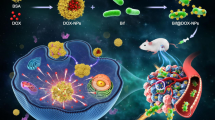Abstract
Development of long-term effective cancer therapy remains a great challenge for both researchers and clinicians. Anaerobic lactic acid bacteria (LAB) possess intrinsic hypoxia tropism to be colonized in tumor niche, and metal-organic frameworks (MOFs) exhibit superior photodynamic responses upon light exposure. However, single treatment of either LAB or MOFs yields unsatisfactory therapeutic outcome. In the present study, an LAB-based drug formulation is prepared to locally generate reactive oxygen species (ROS) in hypoxic tumor and to precisely induce host immunity. These bacteria have been modified by zeolitic imidazolate framework-67 (ZIF-67) and enriched in tumor niche after circulation. The fabricated bacteria facilitate the delivery of ZIF-67 into CT-26 cells, and rapid evolution of ROS is detected after light exposure. The bacterial hybrid induces tumor shrinkage through in vivo photodynamic therapy, and tumor-restricted inflammation attracts both macrophages and T cells for subsequent elimination of remaining cancer cells. Our study provides a material-bacteria hybrid platform for both active tumor targeting and long-term cancer self-immunotherapy.
摘要
开发长期有效的癌症治疗技术仍然是科研工作者和临床医生面 临的重要任务. 厌氧型乳酸菌(LAB)具有天然的乏氧倾向性, 可自发富 集在缺氧的肿瘤微环境中. 金属有机框架(MOF)是一类独特的纳米材 料, 其中的ZIF-67可以自发分解过氧化氢产氧, 且析氧能力可被光照增 强. 然而, LAB或MOF单独应用于肿瘤治疗的效果并不令人满意. 在本 文中, 我们制备了一种MOF修饰的乳酸菌制剂, 用以在缺氧性肿瘤中局 部产生活性氧(ROS)助力光动力治疗, 同时精准诱导宿主肿瘤免疫. 这 些细菌表面被ZIF-67纳米材料修饰(LAB@ZIF-67), 经体内循环后富集 在肿瘤微环境中. 细菌表面的ZIF-67可以被CT-26细胞吸收, 并且在光 照后检测到细胞内快速生成ROS. 体内实验表明, 该细菌复合物可通过 光动力疗法消灭肿瘤, 同时诱导肿瘤特异的炎性反应, 招募巨噬细胞和 T细胞实现肿瘤的免疫治疗. 此类材料-细菌复合物为今后研发肿瘤主 动靶向药物和癌症免疫疗法提供了新思路.

Similar content being viewed by others
References
McQuade RM, Stojanovska V, Bornstein JC, et al. Colorectal cancer chemotherapy: The evolution of treatment and new approaches. Curr Med Chem, 2017, 24: 1557–3322
Tam SY, Wu VWC. A review on the special radiotherapy techniques of colorectal cancer. Front Oncol, 2019, 9: 208
Grewal S, Oosterling SJ, van Egmond M. Surgery for colorectal cancer: A trigger for liver metastases development? New insights into the underlying mechanisms. Biomedicines, 2021, 9: 177
Joharatnam-Hogan N, Shiu KK, Khan K. Challenges in the treatment of gastric cancer in the older patient. Cancer Treat Rev, 2020, 85: 101980
Corso G, Maisonneuve P, Massari G, et al. Validation of a novel nomogram for prediction of local relapse after surgery for invasive breast carcinoma. Ann Surg Oncol, 2020, 27: 1864–1874
Li TZ, Hou XY, Qi Y, et al. Nanomaterials for neurodegenerative diseases: Molecular mechanisms guided design and applications. Nano Res, 2022, 15: 3299–3322
Li Y, Zheng X, Chu Q. Bio-based nanomaterials for cancer therapy. Nano Today, 2021, 38: 101134
Franco YL, Vaidya TR, Ait-Oudhia S. Anticancer and cardio-protective effects of liposomal doxorubicin in the treatment of breast cancer. Breast Cancer Target Ther, 2018, 10: 131–141
Kanwal U, Irfan Bukhari N, Ovais M, et al. Advances in nano-delivery systems for doxorubicin: An updated insight. J Drug Target, 2018, 26: 296–310
Quader S, Kataoka K. Nanomaterial-enabled cancer therapy. Mol Ther, 2017, 25: 1501–1513
Liu Z, Xie Z, Li W, et al. Photodynamic immunotherapy of cancers based on nanotechnology: Recent advances and future challenges. J Nanobiotechnol, 2021, 19: 160
Chen D, Xu Q, Wang W, et al. Type I photosensitizers revitalizing photodynamic oncotherapy. Small, 2021, 17: 2006742
Wan Y, Fu LH, Li C, et al. Conquering the hypoxia limitation for photodynamic therapy. Adv Mater, 2021, 33: 2103978
Guan S, Wang L, Xu SM, et al. Vacancy-enhanced generation of singlet oxygen for photodynamic therapy. Chem Sci, 2019, 10: 2336–2341
Ayan S, Gunaydin G, Yesilgul-Mehmetcik N, et al. Proof-of-principle for two-stage photodynamic therapy: Hypoxia triggered release of singlet oxygen. Chem Commun, 2020, 56: 14793–14796
Li H, Li L, Lin RB, et al. Porous metal-organic frameworks for gas storage and separation: Status and challenges. EnergyChem, 2019, 1: 100006
Hilal ME, Aboulouard A, Akbar AR, et al. Progress of MOF-derived functional materials toward industrialization in solar cells and metal-air batteries. Catalysts, 2020, 10: 897
Tang J, Liu L, Qin J, et al. Biocatalysis-mediated MOF-to-prussian blue transformation enabling sensitive detection of NSCLC-associated miRNAs with dual-readout signals. Biosens Bioelectron, 2022, 206: 114139
Konnerth H, Matsagar BM, Chen SS, et al. Metal-organic framework (MOF)-derived catalysts for fine chemical production. Coord Chem Rev, 2020, 416: 213319
Ding M, Cai X, Jiang HL. Improving MOF stability: Approaches and applications. Chem Sci, 2019, 10: 10209–10230
Lu J, Yang L, Zhang W, et al. Photodynamic therapy for hypoxic solid tumors via Mn-MOF as a photosensitizer. Chem Commun, 2019, 55: 10792–10795
Sun D, Yang D, Wei P, et al. One-step electrodeposition of silver nanostructures on 2D/3D metal-organic framework ZIF-67: Comparison and application in electrochemical detection of hydrogen peroxide. ACS Appl Mater Interfaces, 2020, 12: 41960–41968
Park J, Jiang Q, Feng D, et al. Size-controlled synthesis of porphyrinic metal-organic framework and functionalization for targeted photodynamic therapy. J Am Chem Soc, 2016, 138: 3518–3525
Sun XY, Zhang HJ, Zhao XY, et al. Dual functions of pH-sensitive cation Zr-MOF for 5-Fu: Large drug-loading capacity and high-sensitivity fluorescence detection. Dalton Trans, 2021, 50: 10524–10532
Zhang H, Li Q, Liu R, et al. A versatile prodrug strategy to in situ encapsulate drugs in MOF nanocarriers: A case of cytarabine-Ir820 prodrug encapsulated ZIF-8 toward chemo-photothermal therapy. Adv Funct Mater, 2018, 28: 1802830
Wu MX, Yang YW. Metal-organic framework (MOF)-based drug/cargo delivery and cancer therapy. Adv Mater, 2017, 29: 1606134
Wang D, Wu H, Yang G, et al. Metal-organic framework derived multicomponent nanoagent as a reactive oxygen species amplifier for enhanced photodynamic therapy. ACS Nano, 2020, 14: 13500–13511
Wang SB, Chen ZX, Gao F, et al. Remodeling extracellular matrix based on functional covalent organic framework to enhance tumor photodynamic therapy. Biomaterials, 2020, 234: 119772
Lin D, Feng X, Mai B, et al. Bacterial-based cancer therapy: An emerging toolbox for targeted drug/gene delivery. Biomaterials, 2021, 277: 121124
Zhang Y, Ni Q, Xu C, et al. Smart bacterial magnetic nanoparticles for tumor-targeting magnetic resonance imaging of Her2-positive breast cancers. ACS Appl Mater Interfaces, 2019, 11: 3654–3665
Li T, Gao L, Zhang B, et al. Material-based engineering of bacteria for cancer diagnosis and therapy. Appl Mater Today, 2021, 25: 101212
Galen JE, Wahid R, Buskirk AD. Strategies for enhancement of live-attenuated salmonella-based carrier vaccine immunogenicity. Vaccines, 2021, 9: 162
Zhao T, Feng Y, Guo M, et al. Combination of attenuated Salmonella carrying PD-1 siRNA with nifuroxazide for colon cancer therapy. J Cell Biochem, 2020, 121: 1973–1985
Hernández-Luna MA, Luria-Pérez R. Cancer immunotherapy: Priming the host immune response with live attenuated salmonella enterica. J Immunol Res, 2018, 2018: 2984247
Hu Y, Zhang J, Wang S, et al. Lactic acid bacteria synergistic fermentation affects the flavor and texture of bread. J Food Sci, 2022, 87: 1823–1836
Coelho-Rocha ND, Barroso FAL, Tavares LM, et al. Main features of DNA-based vectors for use in lactic acid bacteria and update protocols. DNA Vaccines, 2021: 285–304
Peng S, Xiao F, Chen M, et al. Tumor-microenvironment-responsive nanomedicine for enhanced cancer immunotherapy. Adv Sci, 2022, 9: 2103836
Yang Y, Yang Z, Yang Y. Potential role of CD47-directed bispecific antibodies in cancer immunotherapy. Front Immunol, 2021, 12: 686031
El Hage A, Dormond O. Combining mTOR inhibitors and T cell-based immunotherapies in cancer treatment. Cancers, 2021, 13: 1359
Weiskopf K. Cancer immunotherapy targeting the CD47/SIRPα axis. Eur J Cancer, 2017, 76: 100–109
Xie Z, Peng M, Lu R, et al. Black phosphorus-based photothermal therapy with aCD47-mediated immune checkpoint blockade for enhanced cancer immunotherapy. Light Sci Appl, 2020, 9: 161
Jin MZ, Wang XP. Immunogenic cell death-based cancer vaccines. Front Immunol, 2021, 12: 697964
Kroemer G, Galassi C, Zitvogel L, et al. Immunogenic cell stress and death. Nat Immunol, 2022, 23: 487–500
Xing C, Chen S, Qiu M, et al. Conceptually novel black phosphorus/ cellulose hydrogels as promising photothermal agents for effective cancer therapy. Adv Healthc Mater, 2018, 7: 1701510
Yan S, Zeng X, Wang Y, et al. Biomineralization of bacteria by a metal-organic framework for therapeutic delivery. Adv Healthc Mater, 2020, 9: 2000046
Wei B, Pan J, Yuan R, et al. Polarization of tumor-associated macrophages by nanoparticle-loaded Escherichia coli combined with immunogenic cell death for cancer immunotherapy. Nano Lett, 2021, 21: 4231–4240
Wu JR, Zhang ZJ, Qiao CX, et al. Synthesis of monodisperse ZIF67@CuSe@PVP nanoparticles for pH-responsive drug release and photothermal therapy. ACS Biomater Sci Eng, 2022, 8: 284–292
de Juan A, Lavin Plaza B. Isolation and culturing of primary mouse and human macrophages. Methods Mol Biol, 2022, 2419: 113–124
Ahmed SA, Bagchi D, Katouah HA, et al. Enhanced water stability and photoresponsivity in metal-organic framework (MOF): A potential tool to combat drug-resistant bacteria. Sci Rep, 2019, 9: 19372
Sung H, Ferlay J, Siegel RL, et al. Global cancer statistics 2020: Globocan estimates of incidence and mortality worldwide for 36 cancers in 185 countries. CA Cancer J Clin, 2021, 71: 209–249
Yan X, Yang Q, Fang X, et al. Co(II)-based metal-organic framework induces apoptosis through activating the HIF-1α/BNIP3 signaling pathway in microglial cells. Environ Sci-Nano, 2021, 8: 2866–2882
Ren SZ, Wang B, Zhu XH, et al. Oxygen self-sufficient core-shell metal-organic framework-based smart nanoplatform for enhanced synergistic chemotherapy and photodynamic therapy. ACS Appl Mater Interfaces, 2020, 12: 24662–24674
Lavy M, Gauttier V, Poirier N, et al. Specialized pro-resolving mediators mitigate cancer-related inflammation: Role of tumor-associated macrophages and therapeutic opportunities. Front Immunol, 2021, 12: 702785
Acknowledgements
This work was supported by the National Natural Science Foundation of China (62005177), the Natural Science Foundation of Guangdong Province (2020A151501612), the Key Project of Department of Education of Guangdong Province (2018KCXTD026), the Science and Technology Innovation Commission of Shenzhen (KCXFZ20201221173413038). Deanship of Scientific Research (DSR) at King Abdulaziz University (KEP-MSc-70-130-42) is acknowledged for technical and financial support. The authors also acknowledge the support from Instrumental Analysis Center of Shenzhen University (Xili Campus).
Author information
Authors and Affiliations
Contributions
Li T and Zhang H conceived and designed the study; Li T engineered the samples; Wang J, Xie Z, and Chen T provided experimental materials; Li T and Wang J performed the experiments; Wageh S, Al-Ghamdi AA, and Yu J participated in the discussion of the study results; Li T wrote the paper with support from Xie Z and Zhang H. All authors contributed to the general discussion.
Corresponding authors
Additional information
Conflict of interest
The authors declare that they have no conflict of interest.
Supplementary information
Supporting data are available in the online version of the paper.
Tianzhong Li currently works as a postdoctoral researcher (2020-) in Prof. Han Zhang’s laboratory at the Institute of Microscale Optoelectronics of Shenzhen University. He finished his PhD study in biomedical science from the City University of Hong Kong (2014–2020). His research interests include multi-modal cancer therapeutics, drug and gene delivery, low-dimensional materials, diagnosis and treatment of neurodegenerative diseases.
Han Zhang is professor and director of Shenzhen Engineering Laboratory of Phosphorene and Optoelectronics at Shenzhen University. He is an expert on low-dimensional optoelectronic devices and applications. His research interests are correlated to the photonic and optoelectronic applications of two-dimensional nanomaterials, such as graphene, transition-metal dichalcogenides, and black phosphorus.
Supporting Information
40843_2022_2141_MOESM1_ESM.pdf
A hybrid of lactic acid bacteria and metal-organic frameworks potentiates photodynamic immunotherapy for hypoxia-targeted tumor eradication
Rights and permissions
About this article
Cite this article
Li, T., Wang, J., Chen, T. et al. A hybrid of lactic acid bacteria and metal-organic frameworks potentiates photodynamic immunotherapy for hypoxia-targeted tumor eradication. Sci. China Mater. 66, 363–374 (2023). https://doi.org/10.1007/s40843-022-2141-7
Received:
Accepted:
Published:
Issue Date:
DOI: https://doi.org/10.1007/s40843-022-2141-7




